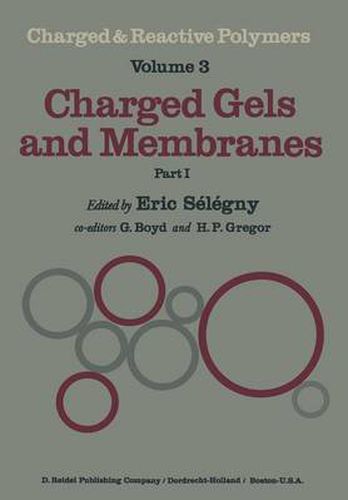Charged Gels and Membranes: Part I
E. Selegny

Charged Gels and Membranes: Part I
E. Selegny
This title is printed to order. This book may have been self-published. If so, we cannot guarantee the quality of the content. In the main most books will have gone through the editing process however some may not. We therefore suggest that you be aware of this before ordering this book. If in doubt check either the author or publisher’s details as we are unable to accept any returns unless they are faulty. Please contact us if you have any questions.
The series on ‘Charged and Reactive Polymers’ was set forth in two volumes concern ing the fundamentals and applications of polyelectrolytes. A follow-up on ‘Charged Gels and Membranes’ would therefore seem appropriate, necessitating, however, some explanation for non-specialists. Theories of the most dilute gels originate in that of concentrated polyelectrolytes: the methods and problems are similar in structural, spectroscopic or thermodynamic properties. The borderline can be situated in dialysis conducted with a ‘bag’ imper meable to polyelectrolytes but not to small ions, solutes and water. One may recall Donnan’s use of such a system to experiment and discover his famous law of unequal distribution of ions of different charge inside and out. Remark ably so, it is the difference in scale which characterizes the difference between poly electrolyte solutions and gels and membranes: the colloidal solution of macro molecules is heterogeneous only on the microscopic level, whereas the gel-solution system is a macroscopically heterogeneous one. A gel is formed when weak or strong cohesive forces counterbalance the dispersing ones (usually by crosslinking) without inhibiting the penetration of solvent and of small solutes into the polymeric network. The solvophile macromolecules cannot invade the total volume of liquid. As a result of phase-segregation excess solution and gel coexist and interact. The macroscopic swelling depends on gel cross-linking as well as on ionic concentration and type and ion-selectivities are observed.
This item is not currently in-stock. It can be ordered online and is expected to ship in 7-14 days
Our stock data is updated periodically, and availability may change throughout the day for in-demand items. Please call the relevant shop for the most current stock information. Prices are subject to change without notice.
Sign in or become a Readings Member to add this title to a wishlist.


